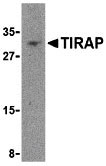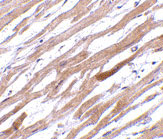TIRAP Antibody
- SPECIFICATION
- CITATIONS
- PROTOCOLS
- BACKGROUND

Application
| WB, IHC-P, IF, E |
|---|---|
| Primary Accession | P58753 |
| Other Accession | AAL05627, 15705407 |
| Reactivity | Human |
| Host | Rabbit |
| Clonality | Polyclonal |
| Isotype | IgG |
| Calculated MW | 23883 Da |
| Application Notes | TIRAP antibody can be used for detection of TIRAP by Western blot at 4 µg/mL. Antibody can also be used for immunohistochemistry starting at 20 µg/mL. For immunofluorescence start at 2 µg/mL. |
| Gene ID | 114609 |
|---|---|
| Other Names | TIRAP Antibody: Mal, wyatt, BACTS1, MyD88-2, MAL, Adaptor protein Wyatt, TIR domain-containing adapter protein, toll-interleukin 1 receptor (TIR) domain containing adaptor protein |
| Target/Specificity | TIRAP; |
| Reconstitution & Storage | TIRAP antibody can be stored at 4℃ for three months and -20℃, stable for up to one year. As with all antibodies care should be taken to avoid repeated freeze thaw cycles. Antibodies should not be exposed to prolonged high temperatures. |
| Precautions | TIRAP Antibody is for research use only and not for use in diagnostic or therapeutic procedures. |
| Name | TIRAP |
|---|---|
| Synonyms | MAL |
| Function | Adapter involved in TLR2, TLR4 and RAGE signaling pathways in the innate immune response. Acts via IRAK2 and TRAF-6, leading to the activation of NF-kappa-B, MAPK1, MAPK3 and JNK, and resulting in cytokine secretion and the inflammatory response. Positively regulates the production of TNF-alpha (TNF) and interleukin-6 (IL6). |
| Cellular Location | Cytoplasm. Cell membrane. Membrane. Note=Colocalizes with DAB2IP at the plasma membrane |
| Tissue Location | Highly expressed in liver, kidney, spleen, skeletal muscle and heart. Also detected in peripheral blood leukocytes, lung, placenta, small intestine, thymus, colon and brain |

Thousands of laboratories across the world have published research that depended on the performance of antibodies from Abcepta to advance their research. Check out links to articles that cite our products in major peer-reviewed journals, organized by research category.
info@abcepta.com, and receive a free "I Love Antibodies" mug.
Provided below are standard protocols that you may find useful for product applications.
Background
TIRAP Antibody: Toll-like receptors (TLRs) are signaling molecules that recognize different microbial products during infection and serve as an important link between the innate and adaptive immune responses. These proteins act through adaptor molecules such as TIRAP and MyD88 to activate various kinases and transcription factors. In TIRAP-deficient mice, TLR signaling in response to TLR2 ligands (using either TLR1 and TLR6 as co-receptors) is totally abolished, suggesting that MyD88 and TIRAP work together and are both required for TLR2 signaling. Furthermore, these mice are also resistant to the toxic effects of LPS and show defects in NF-κB and MAP kinase activation, suggesting that TIRAP is also involed in TLR4 signaling.
References
Vogel SN, Fitzgerald KA, and Fenton MJ. TLRs: differential adapter utilization by toll-like receptors mediates TLR-specific patterns of gene expression. Mol. Interv. 2003; 3:466-77.
Takeda K, Kaisho T, and Akira S. Toll-like receptors. Annu. Rev. Immunol. 2003; 21:335-76.
Janeway CA Jr and Medzhitov R. Innate immune recognition. Annu. Rev. Immunol. 2002; 20:197-216.
O’Neill LAJ, Fitzgerald FA, and Bowie AG. The Toll-IL-1 receptor adaptor family grows to five members. Trends in Imm. 2003; 24:286-9.
If you have used an Abcepta product and would like to share how it has performed, please click on the "Submit Review" button and provide the requested information. Our staff will examine and post your review and contact you if needed.
If you have any additional inquiries please email technical services at tech@abcepta.com.













 Foundational characteristics of cancer include proliferation, angiogenesis, migration, evasion of apoptosis, and cellular immortality. Find key markers for these cellular processes and antibodies to detect them.
Foundational characteristics of cancer include proliferation, angiogenesis, migration, evasion of apoptosis, and cellular immortality. Find key markers for these cellular processes and antibodies to detect them. The SUMOplot™ Analysis Program predicts and scores sumoylation sites in your protein. SUMOylation is a post-translational modification involved in various cellular processes, such as nuclear-cytosolic transport, transcriptional regulation, apoptosis, protein stability, response to stress, and progression through the cell cycle.
The SUMOplot™ Analysis Program predicts and scores sumoylation sites in your protein. SUMOylation is a post-translational modification involved in various cellular processes, such as nuclear-cytosolic transport, transcriptional regulation, apoptosis, protein stability, response to stress, and progression through the cell cycle. The Autophagy Receptor Motif Plotter predicts and scores autophagy receptor binding sites in your protein. Identifying proteins connected to this pathway is critical to understanding the role of autophagy in physiological as well as pathological processes such as development, differentiation, neurodegenerative diseases, stress, infection, and cancer.
The Autophagy Receptor Motif Plotter predicts and scores autophagy receptor binding sites in your protein. Identifying proteins connected to this pathway is critical to understanding the role of autophagy in physiological as well as pathological processes such as development, differentiation, neurodegenerative diseases, stress, infection, and cancer.




